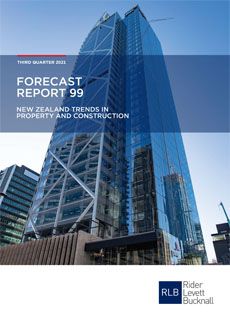According to the Rider Levett Bucknall (RLB) Forecast 99 report – New Zealand Trends in Property and Construction – acute capacity pressures, including strong demand and capacity constraints, have driven the sharp increase in construction costs across New Zealand.
Prepared by the New Zealand Institute of Economic Research (Inc.) (NZIER) exclusively for Rider Levett Bucknall (RLB), Forecast 99 stated that border restrictions are exacerbating labour shortages, with firms unable to hire workers from overseas to keep up with demand.
RLB Director, Mr Grant Watkins said, “Meanwhile, firms are finding it even more difficult to source building materials given continued COVID-related supply chain disruptions. In the near term, containment measures and restrictions have reduced firms’ operating capacity, and this has affected the whole building supply chain.”
Demand for construction leads economic recovery
“There remains uncertainty over how the pandemic will play out globally, and where it will settle, but momentum in the New Zealand economy should support a recovery in activity as containment measures and restrictions are relaxed,” he added.
According to RLB, strong demand for construction has led the recovery in the New Zealand economy over the past year. This bounce-back in demand has been particularly strong for residential construction, and consent issuance points to a solid pipeline of construction work for the year ahead.
Strong population growth most evident in Auckland
Growth in construction activity has been broad-based across the regions, but particularly apparent in Auckland, reflecting the effects of strong population growth in the region over the past decade. Strong housing demand and house price inflation continue to encourage new housing to be built.
The pipeline of residential and government construction work is particularly solid. Residential consent issuance continued to increase to new record highs, with the annual number of dwelling consents totalling over 45,000 for the year to July 2021.
Businesses pass on rising costs
Mr Watkins continued, “Stronger demand has made it easier for businesses to pass on higher costs to customers by raising prices, and short-term inflation expectations have picked up. The Reserve Bank increased the OCR in response to rising inflation pressures, and indicated interest rates are likely to head up further over the coming year.”
Non-residential construction cost escalation accelerated in the June 2021 quarter, as capacity pressures intensified in the sector. The 3.1 percent increase in non-residential construction costs brought annual inflation to 4.6 percent for the year to June 2021.
Labour shortages unlikely to ease
RLB expects non-residential construction cost inflation will be strong over the coming year, reflecting the perfect storm of strong demand and acute supply constraints. Labour shortages in the construction sector are unlikely to ease soon given continued border restrictions and the time required to train the domestic workforce.
“We have forecast annual non-residential construction cost inflation to peak at 10 per cent by March 2022 as firms pass on rising costs given strong construction demand.” Mr Watkins said.
We believe the peak is comparable to the previous peak of 10 per cent seen in the 2004 building boom. We expect a faster moderation in cost escalation this time once border restrictions and supply chain disruptions ease,” he concluded.
Future outlook remains positive
The property and construction sector’s longer-term outlook remains positive despite the uncertainty of the long tail in the latest COVID-19 community outbreak.
However, there are some headwinds. RLB predicts that beyond the short-term disruption from lockdowns and social distancing restrictions, supply constraints will likely hamper the degree to which construction activity can ramp up despite strong demand. According to the firm, strong construction cost inflation may also see some construction projects put on hold as they no longer become financially feasible.
FURTHER INFORMATION:



